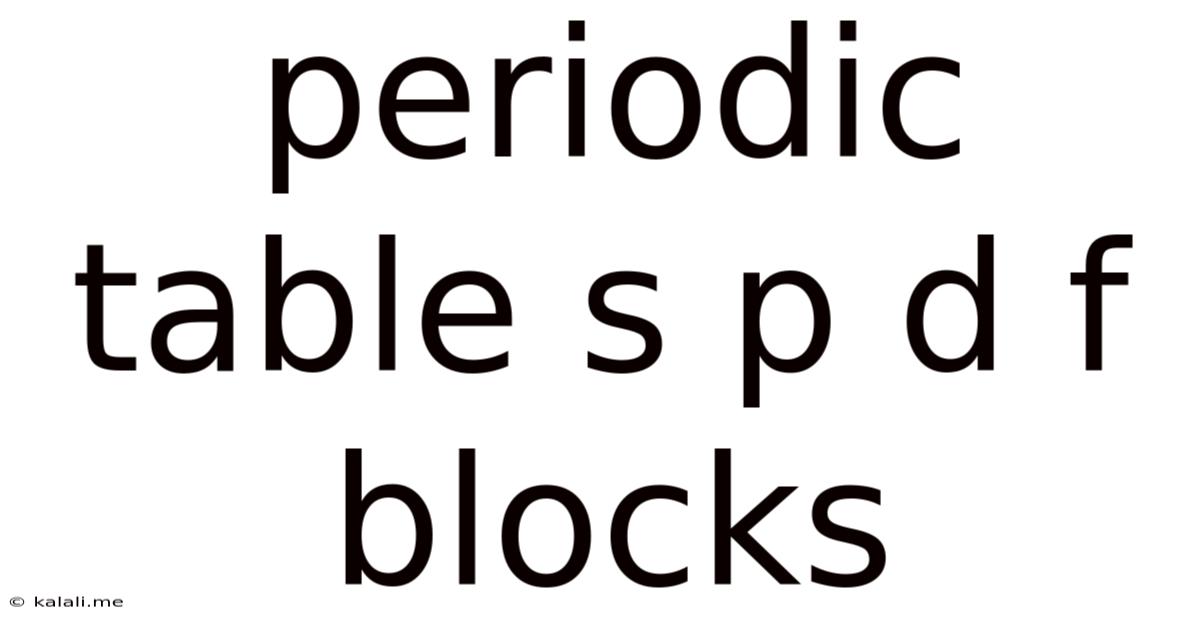Periodic Table S P D F Blocks
Kalali
Jun 11, 2025 · 4 min read

Table of Contents
Understanding the s, p, d, and f Blocks of the Periodic Table
The periodic table, a cornerstone of chemistry, organizes elements based on their atomic structure and recurring properties. Understanding its structure, particularly the s, p, d, and f blocks, is crucial for grasping the behavior and characteristics of different elements. This article will delve into the intricacies of these blocks, explaining their electron configurations and the resulting properties.
What are the s, p, d, and f blocks? These blocks represent the different energy levels and sublevels where electrons reside within an atom. They are named based on the orbital shape of the electrons in the outermost shell which influences the chemical properties. The outermost shell, or valence shell, plays a critical role in determining an element's reactivity and bonding behavior.
The s-block: Alkali and Alkaline Earth Metals
The s-block, located on the far left of the periodic table, includes groups 1 and 2 (alkali metals and alkaline earth metals, respectively). These elements have their valence electrons in the s orbital, which can hold a maximum of two electrons.
-
Alkali Metals (Group 1): These elements (like lithium, sodium, and potassium) are highly reactive, readily losing their single valence electron to form +1 ions. This reactivity stems from their low ionization energy – the energy needed to remove an electron. They are soft, have low melting points, and are excellent conductors of electricity.
-
Alkaline Earth Metals (Group 2): These metals (such as magnesium and calcium) have two valence electrons in their s orbital. They are less reactive than alkali metals but still readily lose their two valence electrons to form +2 ions. They also display metallic properties like good conductivity, although generally less reactive than their alkali counterparts.
The p-block: Diverse Properties
The p-block, encompassing groups 13 to 18, occupies the largest portion of the periodic table. Elements in this block have their valence electrons in the p orbitals, which can hold up to six electrons. The p-block includes a wide range of elements displaying diverse properties, including:
-
Nonmetals: Many nonmetals reside in the p-block, exhibiting characteristics like low conductivity, brittleness, and a tendency to gain electrons to achieve a stable electron configuration. Examples include oxygen, nitrogen, chlorine, and the noble gases (Group 18).
-
Metalloids (Semimetals): Located along the "staircase" dividing metals and nonmetals, metalloids possess intermediate properties. They exhibit semiconducting behavior, meaning their electrical conductivity lies between that of metals and nonmetals. Silicon and germanium are prime examples.
-
Metals: Some metals are also found in the p-block, showcasing properties like good conductivity and malleability, though generally less reactive than those in the s-block. Aluminum is a prominent example.
The d-block: Transition Metals
The d-block, found in the middle of the periodic table, houses the transition metals. These elements have their valence electrons in the d orbitals, which can hold up to ten electrons. Transition metals are known for their:
-
Variable oxidation states: They can readily lose different numbers of electrons, resulting in multiple oxidation states and a wide variety of compounds.
-
Formation of colored compounds: Many transition metal compounds exhibit vibrant colors due to the electronic transitions within the d orbitals.
-
Catalytic activity: Many transition metals and their compounds act as catalysts, speeding up chemical reactions without being consumed themselves.
The f-block: Lanthanides and Actinides
The f-block, located at the bottom of the periodic table, comprises two series: the lanthanides (rare earth elements) and the actinides. Their valence electrons occupy the f orbitals, which can hold up to fourteen electrons.
-
Lanthanides: These elements exhibit similar chemical properties due to the shielding effect of the inner electrons. They are relatively reactive metals.
-
Actinides: These elements are all radioactive, with many being synthetically produced. They are highly reactive and possess complex chemistry.
In conclusion, the s, p, d, and f blocks of the periodic table provide a framework for understanding the electronic structure and resulting properties of elements. This organization allows us to predict reactivity, bonding behavior, and other characteristics, making it an essential tool in chemistry and related fields. By understanding the nuances of each block, one can gain a deeper appreciation for the fascinating diversity of the elements and their interactions.
Latest Posts
Latest Posts
-
How Many Times Does 11 Go Into 40
Jul 01, 2025
-
Elvis Presley Gospel One Pair Of Hands
Jul 01, 2025
-
What Is The Fine For Killing A Buzzard
Jul 01, 2025
-
How Old Am I If I Was Born In 1996
Jul 01, 2025
-
What Is 3 X 3 X 3
Jul 01, 2025
Related Post
Thank you for visiting our website which covers about Periodic Table S P D F Blocks . We hope the information provided has been useful to you. Feel free to contact us if you have any questions or need further assistance. See you next time and don't miss to bookmark.